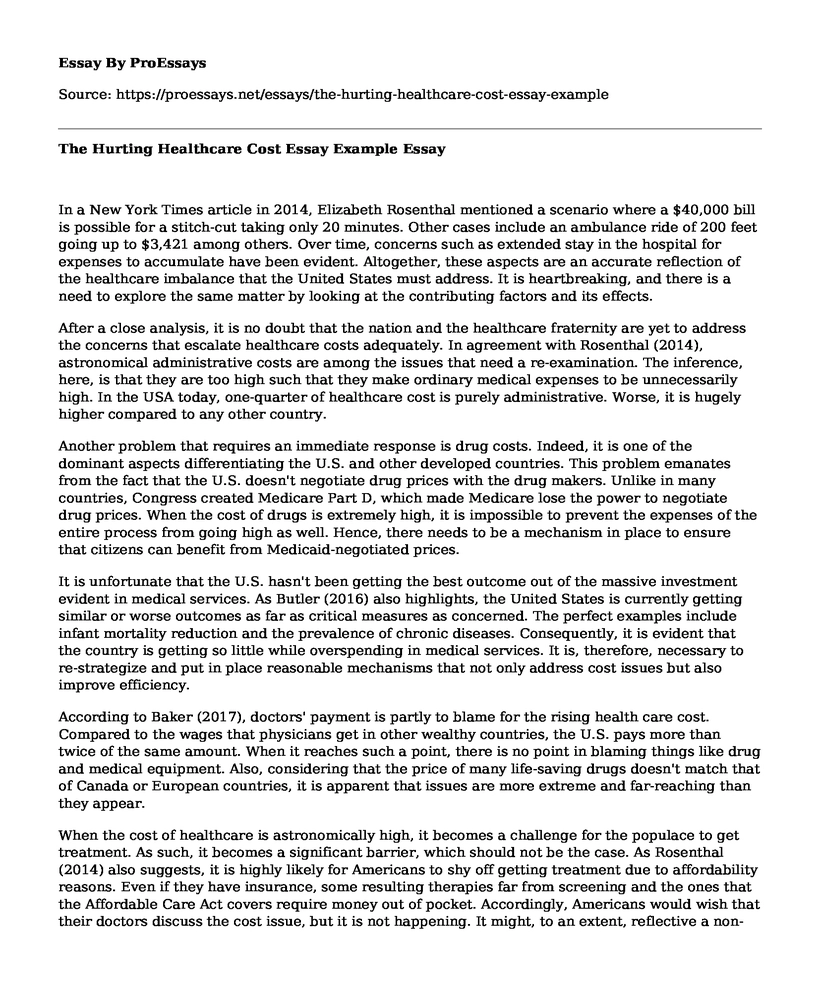In a New York Times article in 2014, Elizabeth Rosenthal mentioned a scenario where a $40,000 bill is possible for a stitch-cut taking only 20 minutes. Other cases include an ambulance ride of 200 feet going up to $3,421 among others. Over time, concerns such as extended stay in the hospital for expenses to accumulate have been evident. Altogether, these aspects are an accurate reflection of the healthcare imbalance that the United States must address. It is heartbreaking, and there is a need to explore the same matter by looking at the contributing factors and its effects.
After a close analysis, it is no doubt that the nation and the healthcare fraternity are yet to address the concerns that escalate healthcare costs adequately. In agreement with Rosenthal (2014), astronomical administrative costs are among the issues that need a re-examination. The inference, here, is that they are too high such that they make ordinary medical expenses to be unnecessarily high. In the USA today, one-quarter of healthcare cost is purely administrative. Worse, it is hugely higher compared to any other country.
Another problem that requires an immediate response is drug costs. Indeed, it is one of the dominant aspects differentiating the U.S. and other developed countries. This problem emanates from the fact that the U.S. doesn't negotiate drug prices with the drug makers. Unlike in many countries, Congress created Medicare Part D, which made Medicare lose the power to negotiate drug prices. When the cost of drugs is extremely high, it is impossible to prevent the expenses of the entire process from going high as well. Hence, there needs to be a mechanism in place to ensure that citizens can benefit from Medicaid-negotiated prices.
It is unfortunate that the U.S. hasn't been getting the best outcome out of the massive investment evident in medical services. As Butler (2016) also highlights, the United States is currently getting similar or worse outcomes as far as critical measures as concerned. The perfect examples include infant mortality reduction and the prevalence of chronic diseases. Consequently, it is evident that the country is getting so little while overspending in medical services. It is, therefore, necessary to re-strategize and put in place reasonable mechanisms that not only address cost issues but also improve efficiency.
According to Baker (2017), doctors' payment is partly to blame for the rising health care cost. Compared to the wages that physicians get in other wealthy countries, the U.S. pays more than twice of the same amount. When it reaches such a point, there is no point in blaming things like drug and medical equipment. Also, considering that the price of many life-saving drugs doesn't match that of Canada or European countries, it is apparent that issues are more extreme and far-reaching than they appear.
When the cost of healthcare is astronomically high, it becomes a challenge for the populace to get treatment. As such, it becomes a significant barrier, which should not be the case. As Rosenthal (2014) also suggests, it is highly likely for Americans to shy off getting treatment due to affordability reasons. Even if they have insurance, some resulting therapies far from screening and the ones that the Affordable Care Act covers require money out of pocket. Accordingly, Americans would wish that their doctors discuss the cost issue, but it is not happening. It might, to an extent, reflective a non-caring culture getting into the system. Also, it is a sign of institutional issues that depict that the U.S. health care is yet to evolve to the levels required.
As the country strives to address the problem, it is also essential to re-examine the issue of defensive medicine. The main concern, here, is that the practice of defensive medicine has become a significant driver of the astronomical health insurance bill. Since doctors fear getting sued, they usually carry out multiple tests even if they are aware of the precise diagnostic procedure (Oliver, 2017). Unlike in other countries as well, doctors and other medical practitioners are known to use a more expensive mix of treatments.
Conclusion
In summation, it is crucial to restate that there is a need for more activism so that the citizens can get the deserved response. Society requires a change at some points and addressing healthcare imbalance would be an incredible step. Fortunately, the issues that contribute to the high costs are known. Accordingly, the U.S. needs to match its cost with other wealthy countries while ensuring that there is a reasonable balance between medical and social spending.
References
Baker, D. (2017). The Problem of doctors' salaries. Politico.
Butler, S. M. (2016). Social spending, not medical spending, is key to health. Brookings.
Oliver, W. (2017). Ending Defensive Medicine Is Key To Containing Health Care Costs. Investor's Business Daily.
Rosenthal, E. (2014). How the High Cost of Medical Care Is Affecting Americans. The New York Times.
Cite this page
The Hurting Healthcare Cost Essay Example. (2022, Sep 05). Retrieved from https://proessays.net/essays/the-hurting-healthcare-cost-essay-example
If you are the original author of this essay and no longer wish to have it published on the ProEssays website, please click below to request its removal:
- Statistics for the Behavioural Sciences Paper Example
- What is the Social Order in Grenada? - Essay Sample
- Delta Health Care Patient Satisfaction Paper Example
- Cause and Effect Essay on Organ Donation and Sale Essay
- Essay Sample on Terrorism: A Growing Threat to Global Security
- Nursing Knowledge Synthesis: From Natural, Social Sciences to Culturally Competent Care - Essay Sample
- 3-Step Approach to Counseling Patients w/ Sexual Dysfunction Concerns - Essay Sample







